To the north of the walled city of Shahjahanabad, lies a small trail that tells you the story of the first revolution of the Indian freedom struggle, the 1857 revolution. That is the year that would always be remembered as a landmark year, as a beginning that had its conclusion after 90 years.

1857 Revolution Delhi – A Walking Trail of Heritage
So if you take Old Delhi or Kashmere Gate GPO as your starting point, within a small walking distance of maybe half a kilometer, you will find so many small signs of the turmoil that Delhi saw along with the important places of those times. GPO itself is an imposing white building with red borders to indicate the postal department. Interestingly, through this walk, we met a woman at each stop who either guided us well or resisted us. But everywhere it was the women whom we met through the walk.
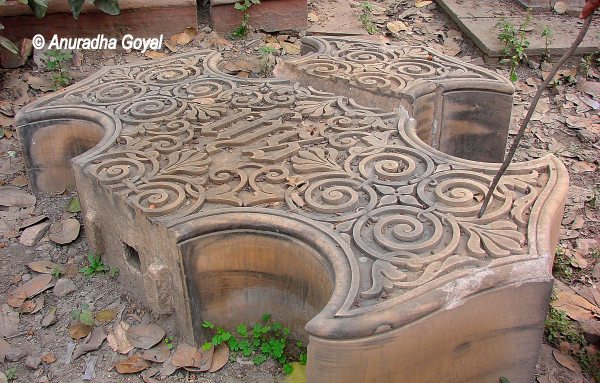
Lothian Cemetery – 1857 Revolution
To begin with, there is Lothian Cemetery which was once the cemetery used by the Christians in Delhi during the first half of the 19th century. There was a huge Celtic cross that was built in this cemetery as a memorial to the people killed in the 1857 revolution. This cross fell a few years back and is in the process of restoration. You can still see it on the ground, lying there, massive and intricately carved as a strong symbol. Post-independence till a few years back, the cemetery was used by families as a place to live.
The families have been moved out about 4 years back and the place has been evacuated. But it is still in a dilapidated state. While you are standing there, you would often wonder, why it is in such a neglected state.
Graves, 1857 Revolution
Some graves are marked and some are not, probably the graves that belong to the war period are not marked. The carved stones or memorial stones have been removed over a period of time. Some of the graves have long epitaphs written. They make interesting reading. Though it can move you when you see the small graves of infants with their grieving parent’s names written on them. Compared to the other cemetery some distance away Nicholson Cemetery, this one is totally neglected.
You would see something peculiar in this small cemetery, the presence of some Mughal red sandstone structures on top of some graves.
Mughal Red Stone structures
I read somewhere that these structures were built by Maj Skinner on the graves of his friends. I guess these may belong to some Muslim gentlemen. When you look around the cemetery and you notice these religious and cultural differences you almost feel that at least in death they lie together. The caretaker lady from ASI told us a bit about this cemetery. When I asked her if she does not find it scary to be all day amongst the graves.
She laughed and showed me the small space where she cooks, eats, and takes rest. And once in a while when the people walk in she has a little talk with them.
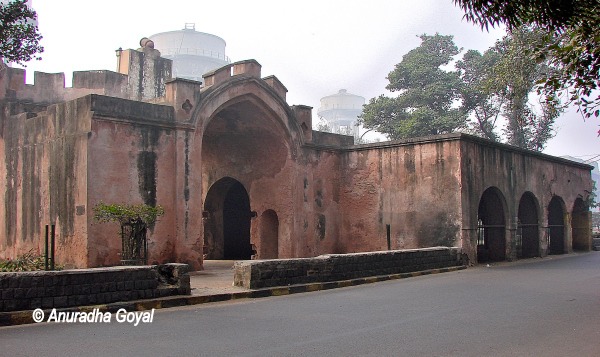
British Magazine – 1857 Revolution
Bang opposite the GPO is a small structure standing by itself. This was a part of the British Magazine, which they themselves destroyed in May 1857, lest it should fall into the hands of rebels. As you walk towards Kashmere gate from here, soon you would see the other remaining and bigger portion of this magazine. Now stand somewhere and imagine an integrated building. And then think of the amount of ammunition that it would have stored. In this second part, you can notice the architecture of this arched building.
A marble plaque tells the names of the soldiers who defended this magazine from the enemies, who were none but freedom fighters. And the government of India has rightly put a board specifying this.
Somewhere in the middle of the road divider, about 100 meters from British Magazine, you would see a small grey stone pillar-like structure. This is the telegraph memorial, in memory of the last message that was sent from here, which informed the army units in Ambala about the mutiny in Meerut and Delhi and which helped the British revive themselves in the 1857 war. There is some inscription on this pillar which we could not read.
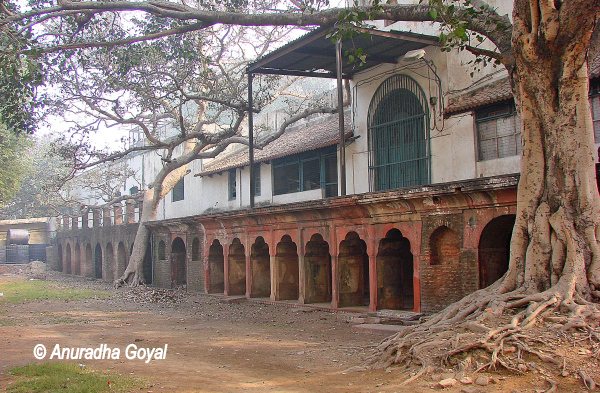
Again as you walk towards Kashmere gate, on your right, you would see Guru Gobind Singh Indraprastha University campus housed in an old British barrack kind of building. One can talk to the security guard and enter the building. You may be asked who are you, as not many tourists come here. You can always say you are a student of history.
Dara Shikoh Library
A little distance inside the gate is Dara Shikoh’s library, built by Shahjahan for his chosen heir and son Dara Shiko, who was eventually murdered by his brother Aurangzeb. This building later became the residence of the first British official in Delhi David Ochterlony. Between the two of them, the building changed hands with various people including Ali Mardan Khan and Marathas. Currently, it serves as the office of the archeology department of the Delhi Government.
Archaeological Museum
There is an archaeological museum in this building now. Showcasing terracotta excavations from the late Harappa period, including the Grey Pottery that is usually associated with the Mahabharata period. Most of these have been excavated from Mandoli and Bhorgarh. Both these sites lie on the outskirts of current-day Delhi.
Mughal & British Architecture
Now, what makes this building different is the superimposition of British architecture on top of the Mughal one. The original library was obviously completely Mughal, but the British added their trademark columns to add a verandah around the building. They also built arched pavilions at the backside basement of the building around the original pavilion. One look and you notice the difference in the architectural style of the two pavilions. All this makes this building very Mughal in interiors and absolutely British in exteriors.
The books of this library were lost during the 1857 Revolution war. How I wish someone has preserved the books. Here a lady from the archeology department very gracefully explained to us the various artifacts and their periods. Also guided us towards the back of the library to see the arched pavilions which otherwise we would have missed.
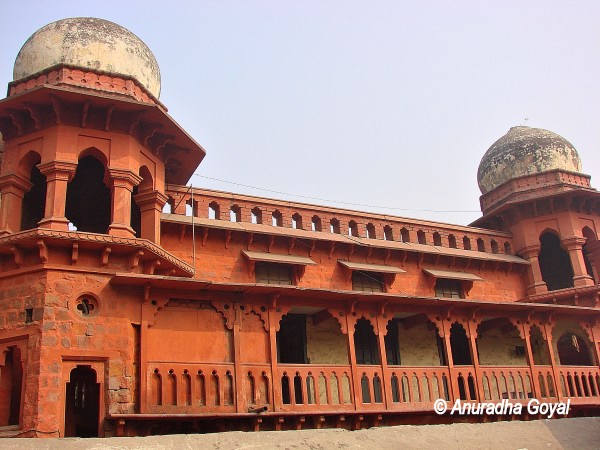
The old building of Stephens College
Come out of the campus and walk on the Lothian road, and notice the old Havelis with various types of facades, still maintained from the 19th century. The intricate jaali work that is on the parapets of all the houses, which are above the shops, is worth noticing. Some had mixed the styles by putting red pillars along with the Jaalis. And some have just played around with the Jaali patterns. Round windows seemed to be in fashion then.
There is an old St Stephens College in bright red color which is now an NCC office. Interestingly the road is called Madarsa Road as this building was once a Madarsa. The whole place still radiates an aura of the bygone era.

St James Church
A little ahead is, what I think is the most beautiful church in Delhi: St James Church. It is housed in a huge campus in yellow and white color. Surrounded by huge gardens, well maintained, almost like an island of peace in the midst of all the chaos. You may be a bit confused about where to enter it from. You can use the main gate or the back gate through the church bookstore. If it is not a Sunday, you may find the church almost deserted, which I find a very welcome sign at times. It is a triangular structure with three doors leading you inside the church.
Here and there on the outer walls, you would see the small stones embedded in the walls of the church, indicating the donations made for the maintenance of the church, and you would see a lot of non-Christians who have contributed to this building. There is a small red-colored structure in the back corner of the book which is the publication house associated with the church and you can buy books from here. You are not allowed to take photographs inside the church and that is a pity as it is beautiful out there.
Stained Glass Paintings
There are two huge stained glass paintings, adding vibrancy to the otherwise not-so-colorful interiors. There is James Skinner’s grave right at the altar, who built this church in the early 19th century. You can read here about his life, his Scottish father and Rajput’s mother, and how he raised a cavalry regiment called Skinner’s Horse. The whole atmosphere inside the church was engrossing and you could just soak yourself in that.
One of the plaques there said that the church has been recently restored by INTACH. You have to appreciate the work done to keep the church in such a pristine state. This church was also destroyed substantially in 1857 and was restored later.
Graves of Skinner Family – 1857 Revolution
To the north of the church are the graves of the Skinner family. And some martyrs of the 1857 war. It also has the grave of William Fraser whose Bungalow is just around the corner. The beautifully sculpted pieces on these graves make the whole piece of land look beautiful. Interestingly you will find epitaphs written in Urdu on some of the Skinner family graves. These pieces are fiercely guarded with heavy fencing. And the lady in charge of the church would keep a keen eye on you while you look at the church.
Here the lady in question was not very friendly. She kept insisting on buying the books and wanted us to leave our bags and cameras outside. So we had to take turns and see the church.
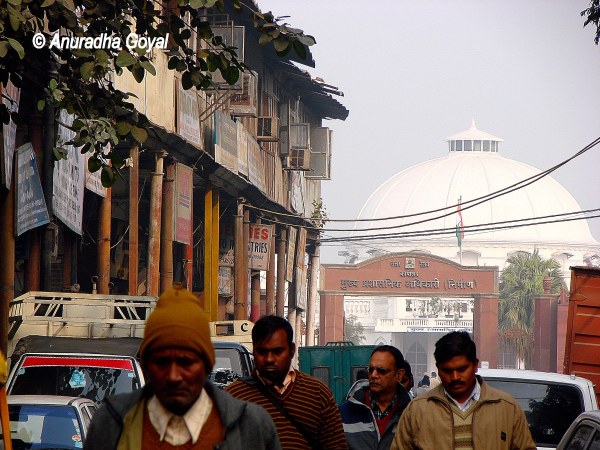
William Frazer Bungalow
Come out of the St James Church and down the road is a beautiful white dome shining at the end of a street. Your immediate impulse is to run to it and see what is it. But you might also notice the European-style marketplace as you step out of the church. This beautiful building was William Fraser’s Bungalow. And is now the office of the Northern Railway. You are not allowed inside the building and photography is a strict no-no.
You are not even allowed to photograph the board that tells the history of the building. Built-in 1803, this was originally the Tehkhana (dungeon) of Ali Mardan, a Mughal viceroy of Punjab.
Domes
Interestingly the domes built on top of this building are very Rajputana in character, and it seems that the architecture of the time either had influences from surrounding areas or the people involved in the building brought in their influences. Nevertheless, it is an enchanting building. Unfortunately, you can only see it from a distance.
CPO Building
Move a little ahead towards Kashmere gate and you will see another imposing white-colored building which is obviously very British in nature. We had no clue, but something about that building attracted us. And we stepped in to discover that it was the office of Urdu and Sindhi Academy. Once upon a time, this was the office of the Chief Police officer. Hence the building is called a CPO building. It is a heritage building, maintained close to its original style. But not many people seem to have noticed it.
As told by an Urdu academy official that they try to underplay the heritage nature of this building, otherwise the culture ministry may take it over. Wonder if they can keep such a huge building under wraps.
Behind this CPO building is a city court and you can see the advocates and their associates sitting out on their chairs and tables with their typewriters. There is another security forces building and behind that is an execution well. Remember the road behind, which is the ring road today, used to be the course of Yamuna in the last century. Now when people used to get
Execution Well of the 1857 revolution
Now when people used to get the death sentence, they used to be executed in this well, and from here their bodies used to flow into the Yamuna River. It is more like a garbage dump today, but when you hear the locals tell the execution stories, it still gives you Goosebumps. A lady working there actually pointed this well to us and told us to go and see it. And an armed forces person explained how it worked.
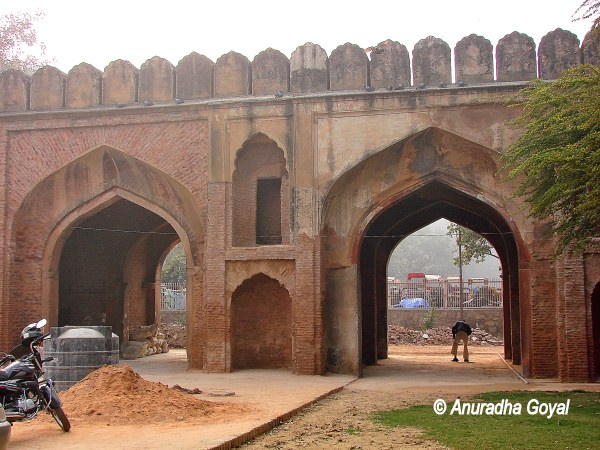
Kashmere Gate – 1857 Revolution Monument
The Kashmere gate is one of the many gates that lead to the walled city of Shahjahanabad. This is the only gate with two arched gateways and was made so by the British. One gateway was for entry and the other was for exit. This northern gate was so named because the kings used to go through this gate to Kashmir during the summer months. Delhi summers it seems were ever so dreadful.
This gate is historically important as this was the point at which the fiercest battle was fought between freedom fighters and the British before the British regained control over Delhi in September 1857. The signs of destruction are still visible at the gate.
Market
Later when the British established Civil Lines as their residential area, the area around Kashmiri Gate became a busy marketplace. You can see the round markets with thin iron pillars and go-around Corridors, not very different from the CP market design. There is an erstwhile famous Ritz cinema hall. Which I was told is no longer operational. Evoking nostalgia for the single-screen theaters and the landmarks that they used to be.
The latest landmark in the area is, of course, the new swanky Metro station. Which has definitely made some space on the roads beneath it?
Burra Bazar Delhi
A road from Kashmiri gate towards Chandni Chowk would lead you to Burra Bazar, which is again a very European imprint. Here you would find a lot of eating joints and other everyday shops. We were told that Mithan Halwai is the best to eat at. But when we reached the place, there were 3-4 Mithan Halwai shops in a row, along with a hardware shop of the same name. There was no way to find out which one was the original. We assumed that all of them must be original, getting divided over the generations. And stepped inside one of them for our lunch. The
The Bedmi aloo puri is something that they specialize in apart from Rabri and Jalebi. There were these huge Kadhai’s filled with milk kept on fire to let it condense. The Puri was very tasty and different as though it was fried, it was almost dry.

In one of the by-lanes of Burra Bazar is the Madrasa Aminia Islamia Arabia, which was originally started in Sunehari Masjid in Chandni Chowk and was later shifted here. Made of Lakhori bricks the mosque adjoining this Madrasa was built by the Nawab of Panipat. There are rooms here which I think are the hostels. As I could see a lot of young boys there, or maybe it was a Sarai at some point in time.

Shops & Market
While walking around this area, stop by to look at interesting signs like the one we spotted advertised a Pahalwan. There are old bookshops like Atma Ram and Sons, that are stuffed with books old styles. You have to make your way to the shop by jumping and hopping on smaller piles of books. Gosh, how I love to roam around in these shops. Then there may be people making snacks on the roadside in a makeshift kitchen. If the surroundings do not bother you, try and taste the fresh snacks right out of the frying pan and it may make you ask for more.
You can also look at the top of buildings, where you would see kids flying kites. You may also spot some people playing with their tamed pigeons. Some of them would be training and feeding them. Someday I want to go to some of these people and see the trained pigeons.
This short walk takes you through a long era in Delhi, India.














Very interesting!
Hi Anuradha,
Very nice heritage walk. Living in Delhi, we at times forget it is as historical a city as any another. Maybe I will do this walk before winter wears out. Intersting find!
Vasudha
Nice work Anu. Will try to remember this walk during my next visit to Delhi.
Good, good, we will catch up 🙂
So vivid! I wish the pictures in article bear titles for better correlation with text.
Hi Anuradha,
I just spotted your blog, Considering I’ll be visiting Delhi in a few months, your posts have just about given me a sort of tour guide 🙂 Thanks!
i know that entry is not allowed in william fraser bungalow but I think the permission can be taken from the GM, Baroda house.
ur blog is simply amazing… I travel daily through this route and being an archeology lover I knew abt almost all sights but not about the execution well… I am gonna see that soon, thanx to you 🙂
I lik dis type of photowork, actually I m fond of hystorical pics & events.u hv don vry well. keep it up.congrats
This is interesting and I would like to do it on my coming return to Delhi. I am a writer who was born and brought up in India and return annually. My ancestor was commander in chief of India and was one of the four generals who ended the first Indian Revolt.
Wow Aline, it is so good to hear from you and connect to the real people behind the historical events through my writings. I do not live in Delhi any longer but do let me know when you are here, would love to catch up with you.